Often, photographs reach their true potential only in the fullness of time.
A photograph is typically first captured for a contemporary audience, one that lives in the world it depicts. Thus a candid photo is born in the present tense, and it is shared and traded as a representation of the times we are living, for enjoyment today and for remembrance at a later time.
But in this capacity, its term of service is limited. Even as lives go on, and times change, photos stay doggedly the same, persistently preserving the minute details of moments whose relevance is constantly receding. At some point, these tokens of the past lose their immediacy and begin to get in the way, as they vie for space and attention with matters of the present. Soon they become relegated to an out-of-the-way corner, one that we devote to things that we rarely use but still want to keep — perhaps in a dusty box in a closet, or in a zip archive whose filename we keep forgetting. There we leave them to hold court as they might, entertaining a diminishing schedule of increasingly infrequent visits until, perhaps, we no longer visit them at all.
Cocooned
But rather than a dead end, often this neglect merely marks the beginning of a sort of incubation, from which neglected negatives and uninteresting images might someday emerge to a new generation — bearing an entirely new relevance that is every bit as robust as the first.
My family’s photo collection followed this path quite faithfully. As I described briefly in a previous article, my father shot a lot of photos, and often developed and printed his own film. This left us with a huge collection of printed snapshots, shadowed by several cigar boxes of negatives in various formats, many of them left uncut and most of the frames unprinted. As a child, sometimes I would delve into the negatives and carefully unroll the coils, trying to see what they depicted. But in these reversed images, all I could see were puzzling shadows and darkened figures with eerie white eyes, staring back at me zombie-like, as if pleading to finally be freed from their remote, inscrutable world. Not having a way to print them, I eventually lost interest.
Soon I had grown up and moved away, but those negatives continued to incubate in a box, enjoying neither my nor my parents’ attention — until one day, many years later, when I inherited them.
Finally, I scanned them all. Not only did it unwind many forgotten threads of my childhood curiosity, but I also found that many of the images had attained a new historical significance, arranged for them by the persistent passage of time.

Photos from inside Cunningham’s Drug Store, 130 W. Michigan Ave, Ypsilanti
In this article, we will view for the first time a set of my father’s negatives that I believe hold some historical interest. They were taken in 1951 and possibly 1952 at a Cunningham’s Drug Store, located at 130 W. Michigan Avenue in Ypsilanti, Michigan (Cunningham’s was a Michigan chain of drugstores, now defunct, and said to have eventually been absorbed into Walgreen’s).
My father worked at Cunningham’s for a time while in college, and apparently took his camera there on several occasions. As far as I can tell, the majority of these negatives have never been printed, as they were never cut apart and only a few of them appeared in our print collection, substantially cropped. They are interior scenes, quite rare for the time, shot with a flash bulb on relatively large-format 120 film. As such they capture a lot of incidental detail that can help us understand how these local midcentury drugstores were organized and operated.
Almost any photo contains two main elements: an intended subject –- perhaps a person, a pet, or a thing -– and a background that comes along for the ride. A good photographer gives the background a supporting role in lending context and composition, but still considers the subject as the most important thing. Yet, to the newfound audience of an antique photograph, often the subject has become the least important thing. Instead, we may be much more fascinated by the background – the signs, the ads, the bystanders, and all the other clutter that was completely unimportant to the photographer at the time. In its sheer candidness, the background often records the mundane, ephemeral things that no one thought important to preserve. Often, that’s exactly what today’s audience is starving to see — and we see it at work in each of these images.
Sequence 1
In the photo below, the first of 11 frames on a roll of 120 film, we see a man standing in front of Cunningham’s liquor counter. The clock reads 10:10. Is it morning or night? Probably night — there appear to be glass blocks in the wall above the shelves, and there is no light coming through. The man’s identity is a mystery, which limits his interest as a subject today. But we can still recognize some of the brands of whisky, and can even make out some of their prices. We can also see some of the products that cluttered the floor and the counter of this well-stocked store. Later frames will confirm that this store was able to cram a surprising diversity of merchandise into a very small space.
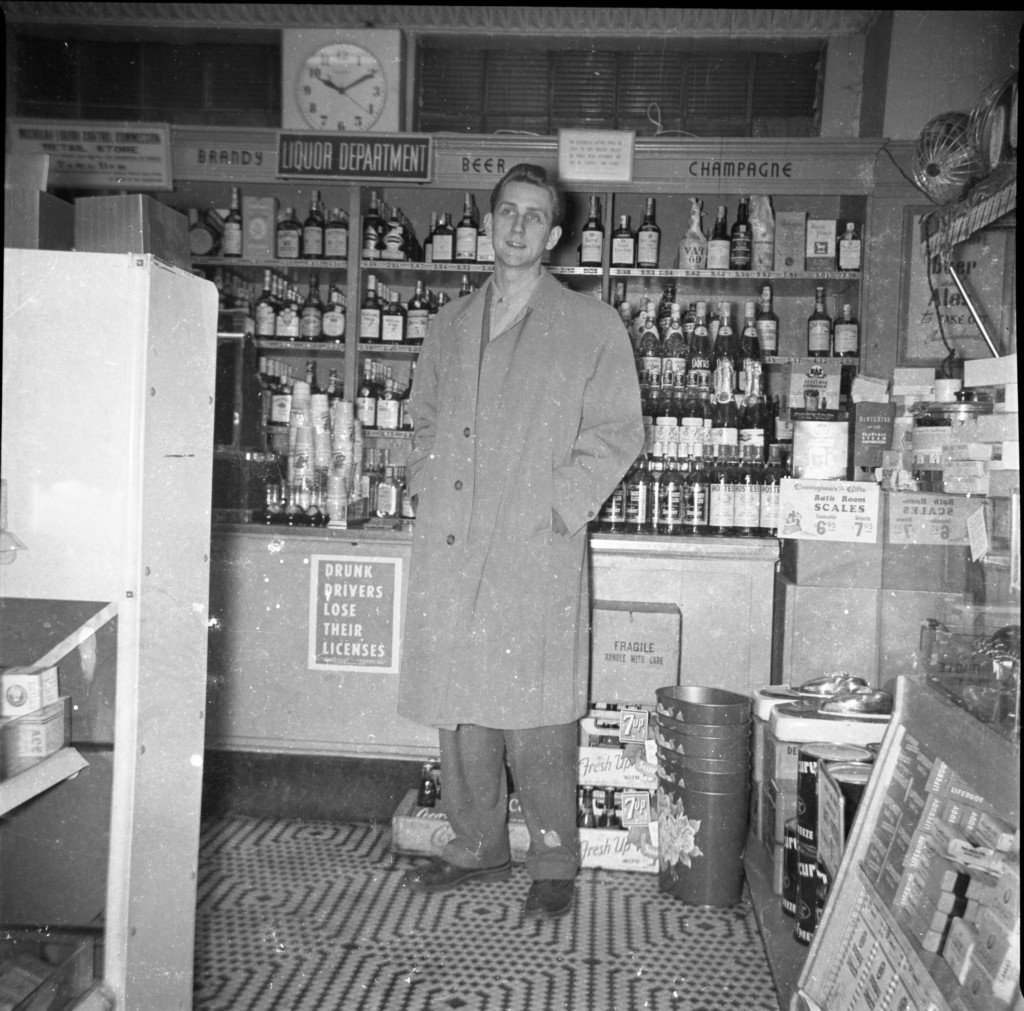
On the strip of negatives, this photo was followed by two photos that were taken at my father’s home. I won’t bore you with them here, except to mention that their presence is very helpful: in one, there is a calendar on the wall, and it is turned to December 1951.
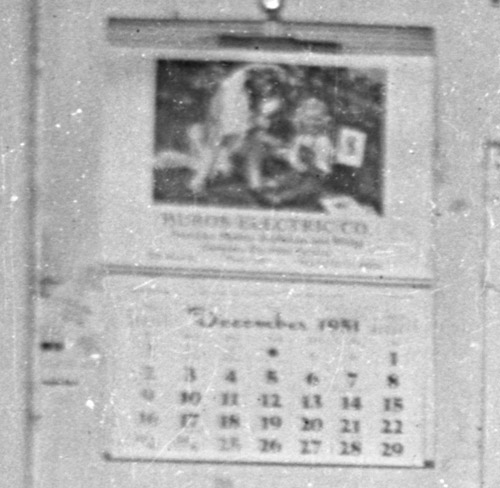
This gives us some idea of when the other photos may have been taken. Of course, in those days, it was not uncommon to keep the same roll of film in the camera for weeks or months, waiting for the right occasion. But in this case, my father seems to be on a camera binge. The December calendar photo is sandwiched between store photos in which people are wearing winter coats, so I think we can assume they were all taken at about the same time.
In the next frame below, we have returned to Cunningham’s. Again, it seems to be at night, as attested by the glass blocks at left, which are again dark.
Cunningham’s was known for its popular soda fountain and lunch counter, and this is what it looked like. Three servers are behind the counter, and three apparent customers in front. While one of the servers seems to be looking toward a customer, another is already smiling for the camera; the third has spotted the camera, and looks a bit uncertain about what’s going on. Two of the customers are turned to the camera, looking a bit nonplussed.
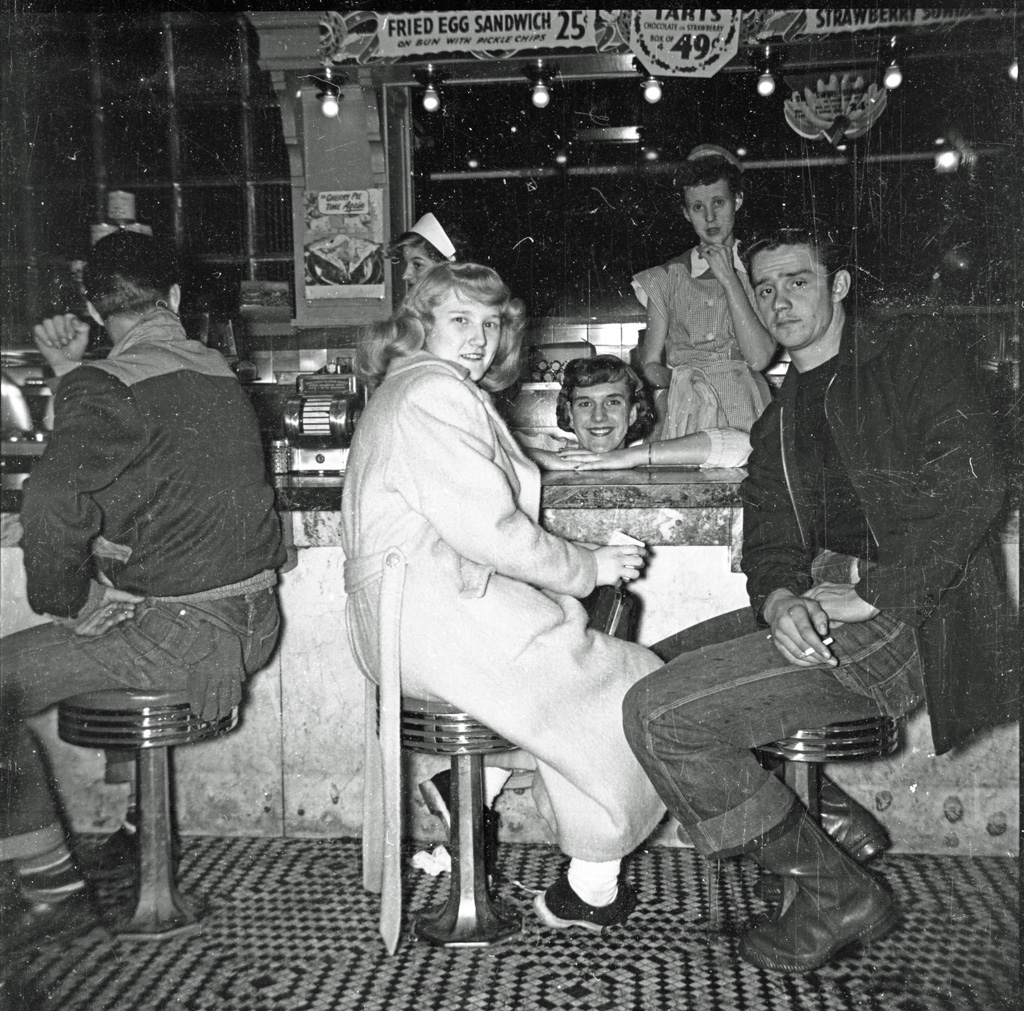
Now here’s the Cunningham’s pharmacist at work. Wait, what’s he pouring into that beaker? We can’t read the label, but it looks like it may have been borrowed from the liquor department. Perhaps the resemblance of an apothecary beaker to a Pilsener glass is not entirely coincidental. It could be, then, that these photos mark a special occasion.
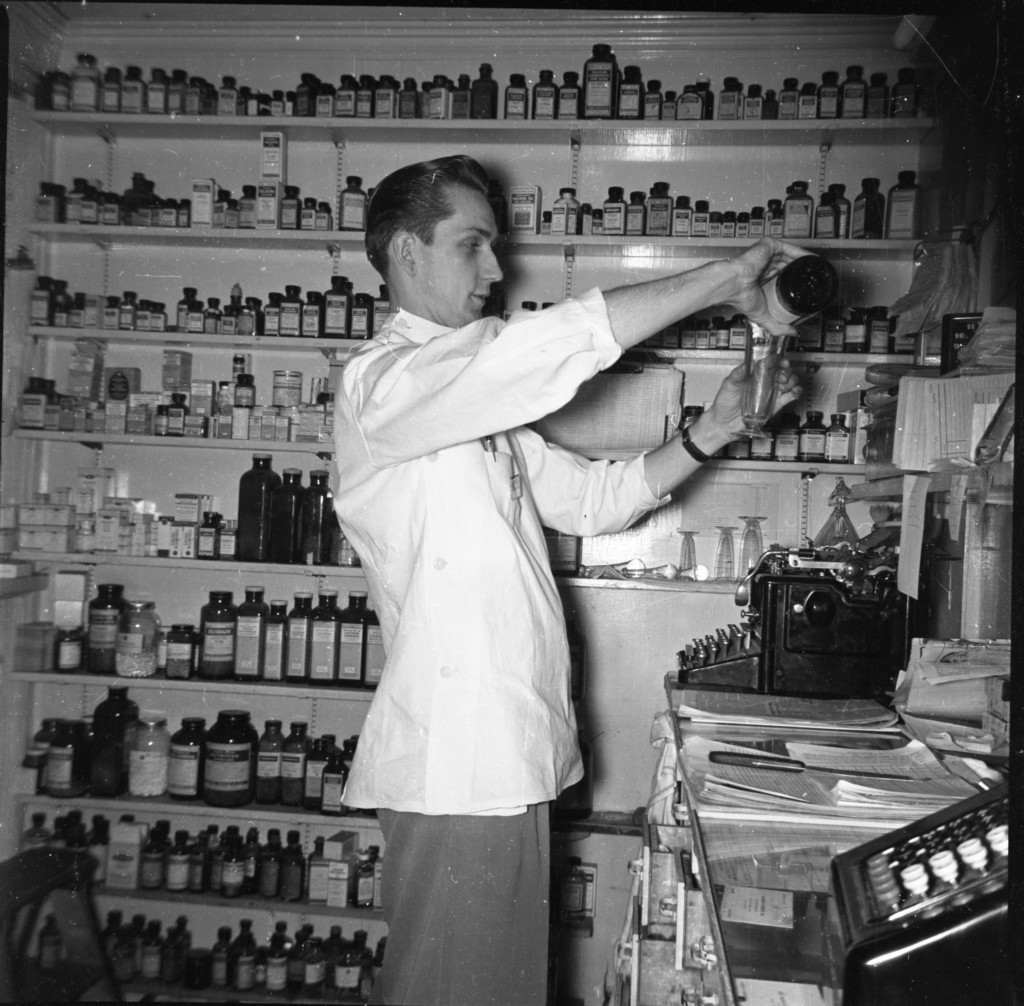
Now we’re back at the lunch counter. The woman on the right already struck a pose in a previous picture, but here they both appear a little hesitant, their hands braced against the sink. Maybe it’s because there’s still a customer at the counter, whose sleeve we can see.
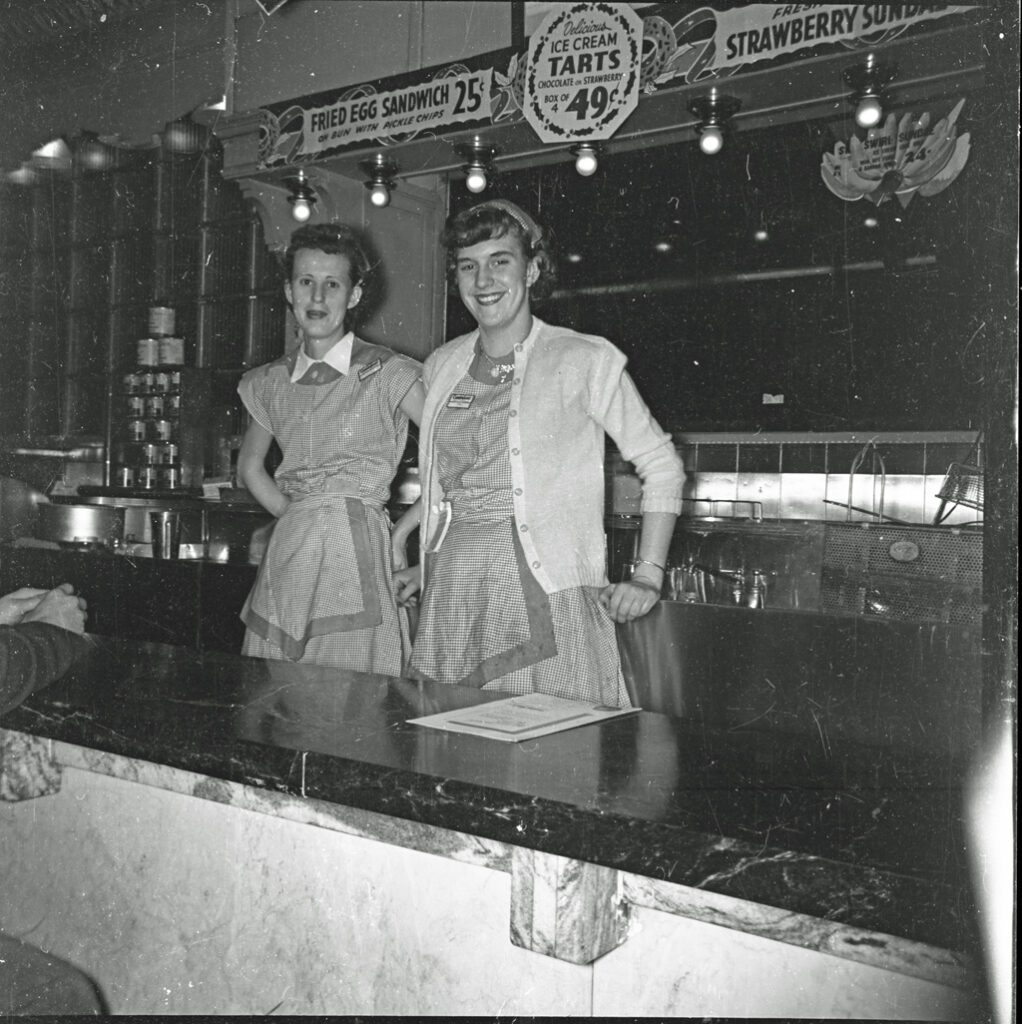
Now a third server steps in to liven things up. In the foreground of this cheerful trio is yet another server, apparently sitting at the counter. She’s identifiable by what we can see of her uniform, and the order pad clipped to her waist. Maybe she’s on break.
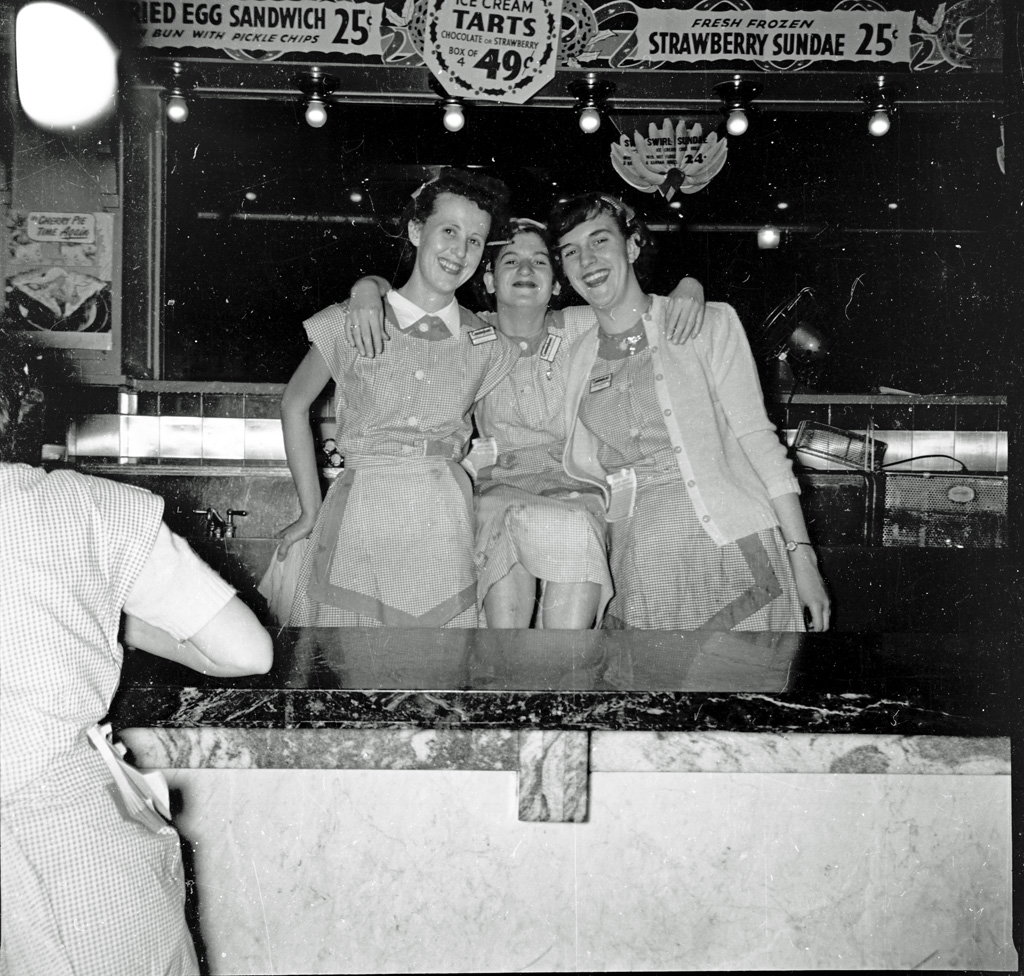
Now the fourth server has joined the troupe, all posing with delight for my father’s flash. She’s almost certainly the one whose elbow we saw in the previous frame — because how could Cunningham’s small lunch counter possibly have needed more than four servers, on a cold December evening?
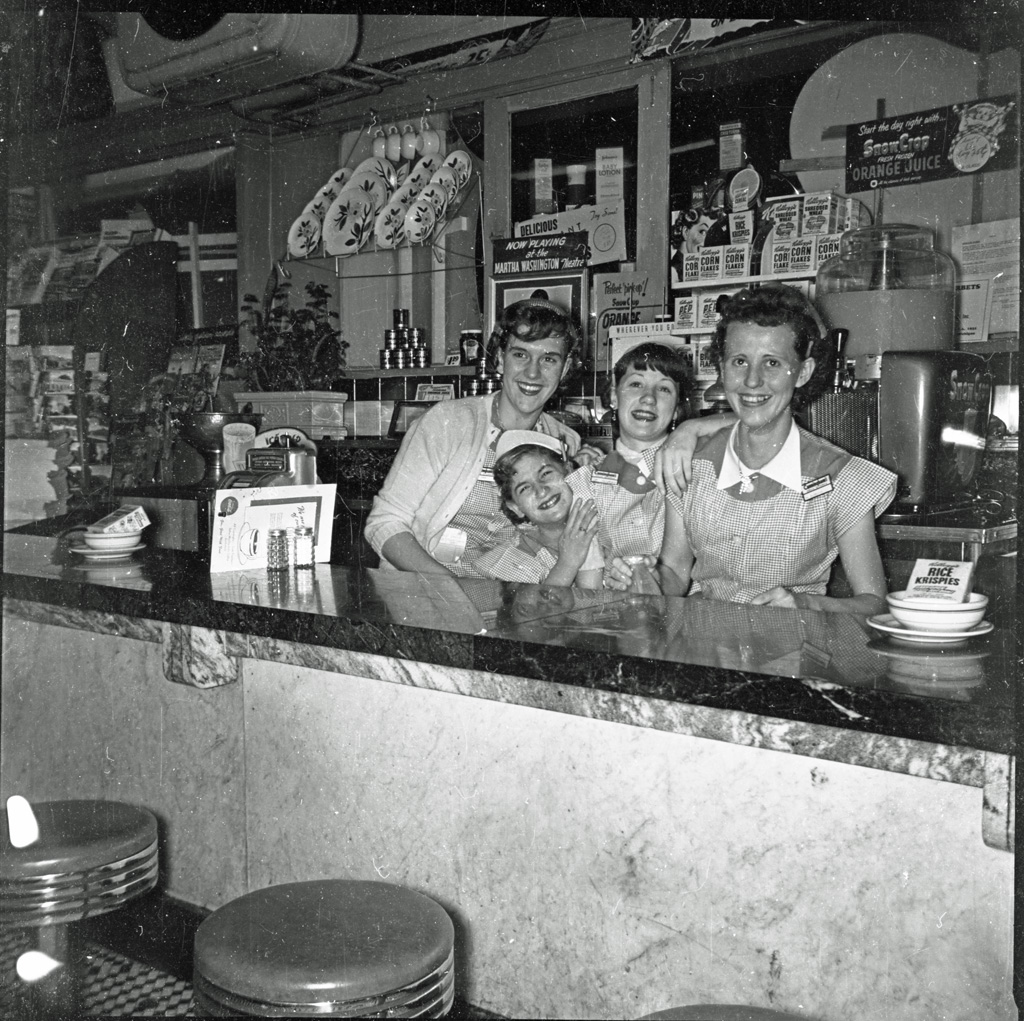
The boxes of Rice Krispies on the counter, each residing suggestively in its own bowl, make me wonder if this was a long-forgotten Cunningham’s tactic for marketing their breakfast lineup. On the shelves we can see more single-serving boxes of Kellogg’s Corn Flakes, Shredded Wheat, Pep (what was that?), and Bran Flakes. If these pictures were taken at night, perhaps it’s late, and the staff has staged the bowls on the counter as part of the setup for the next morning.
Below, we are led to wonder if my father had a special connection with one of the ladies. He has dedicated the frame to her, and this is one of the few frames of the sequence which I saw as a print. As a child, I encountered it many times, uncaptioned; her serene, thoughtful bearing, as she seemed to gaze wistfully into space from the kitchen of some greasy diner, made me feel that this was one of the prettiest girls I’d ever seen.
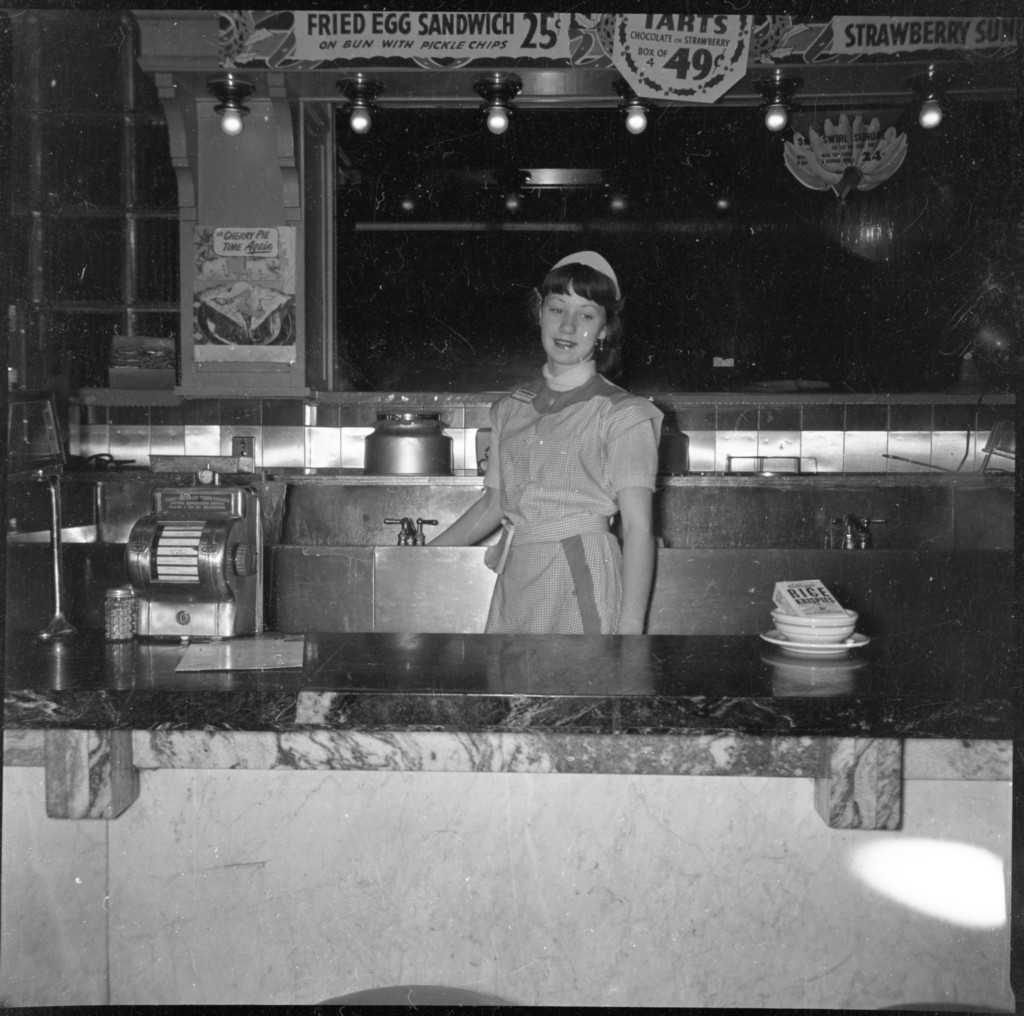
But seeing now the next frame, my childhood interpretation falls into serious doubt. It suggests that the camera just caught her in a random glance, as she was reaching into the sink to grab a sponge.
We can only speculate why she then used it to mop the forehead of her coworker. There must be an inside joke going on.
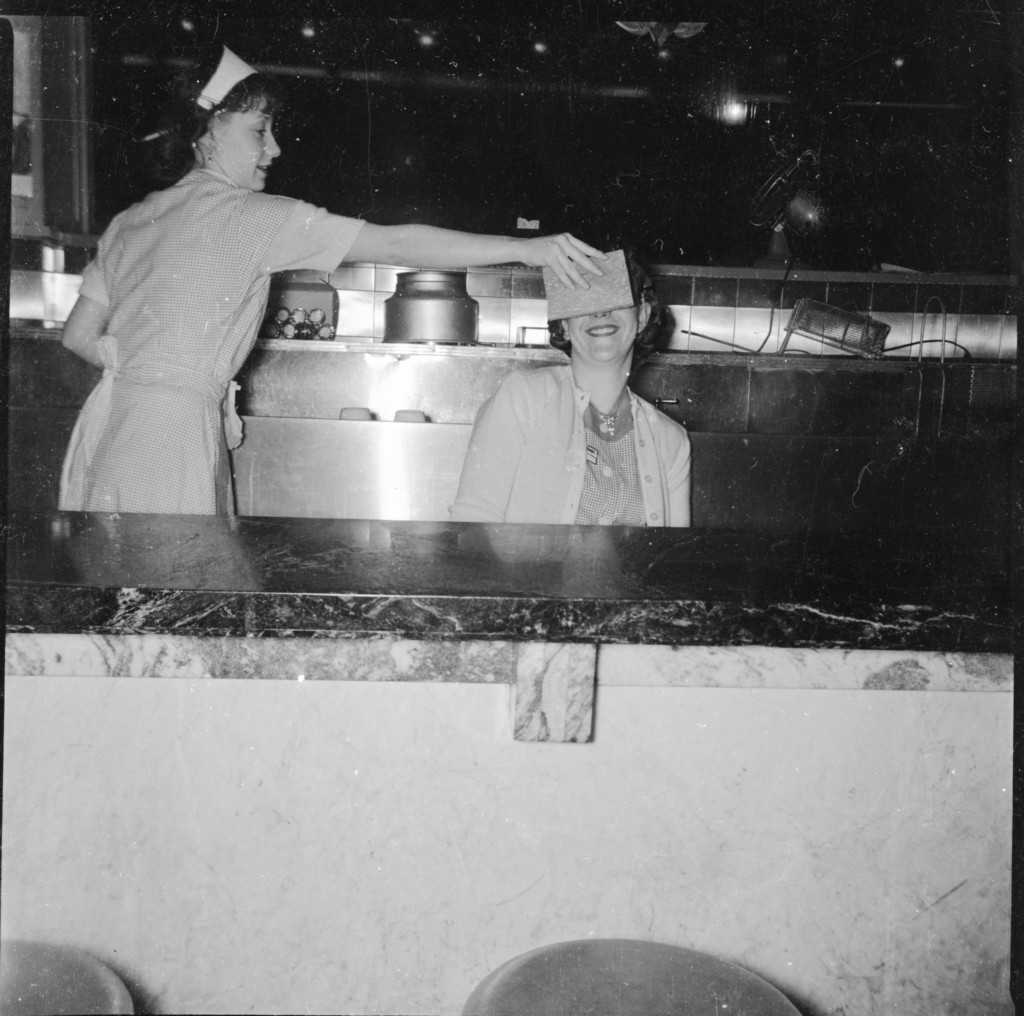
Too late for a fried egg sandwich
Now the servers seem to be going home, and my father has stepped into the frame for a hug from his favorite. He still has his smock on, so they don’t seem to be leaving together. Given that he would be marrying my mother (who is not pictured) in just a few months, I’m guessing that these two are just sharing a friendly goodbye.
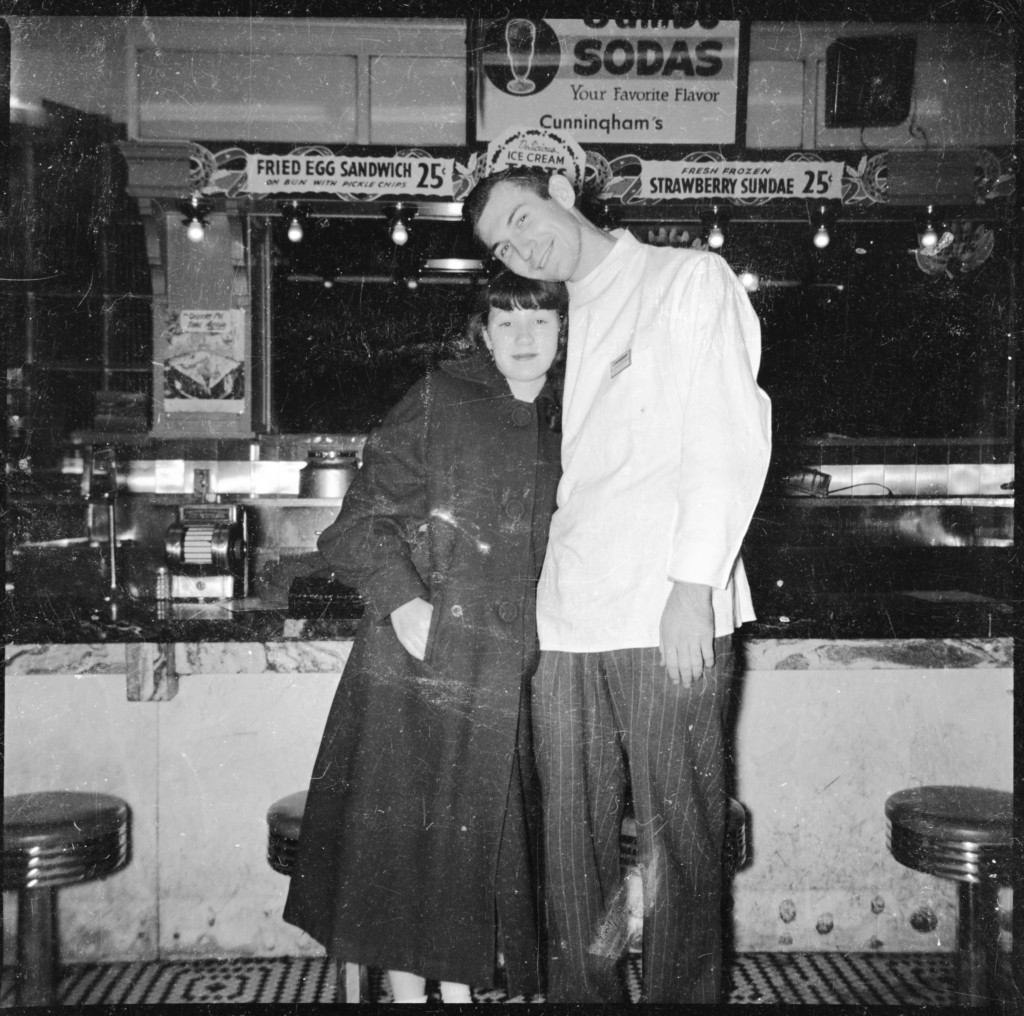
Sequence 2
On another strip of film we find another sequence, featuring various in-store portraits of a woman who I don’t know. Here she’s posing in front of the cosmetics counter. She seems to be dressed in a smock of some sort, so she probably works in the store.
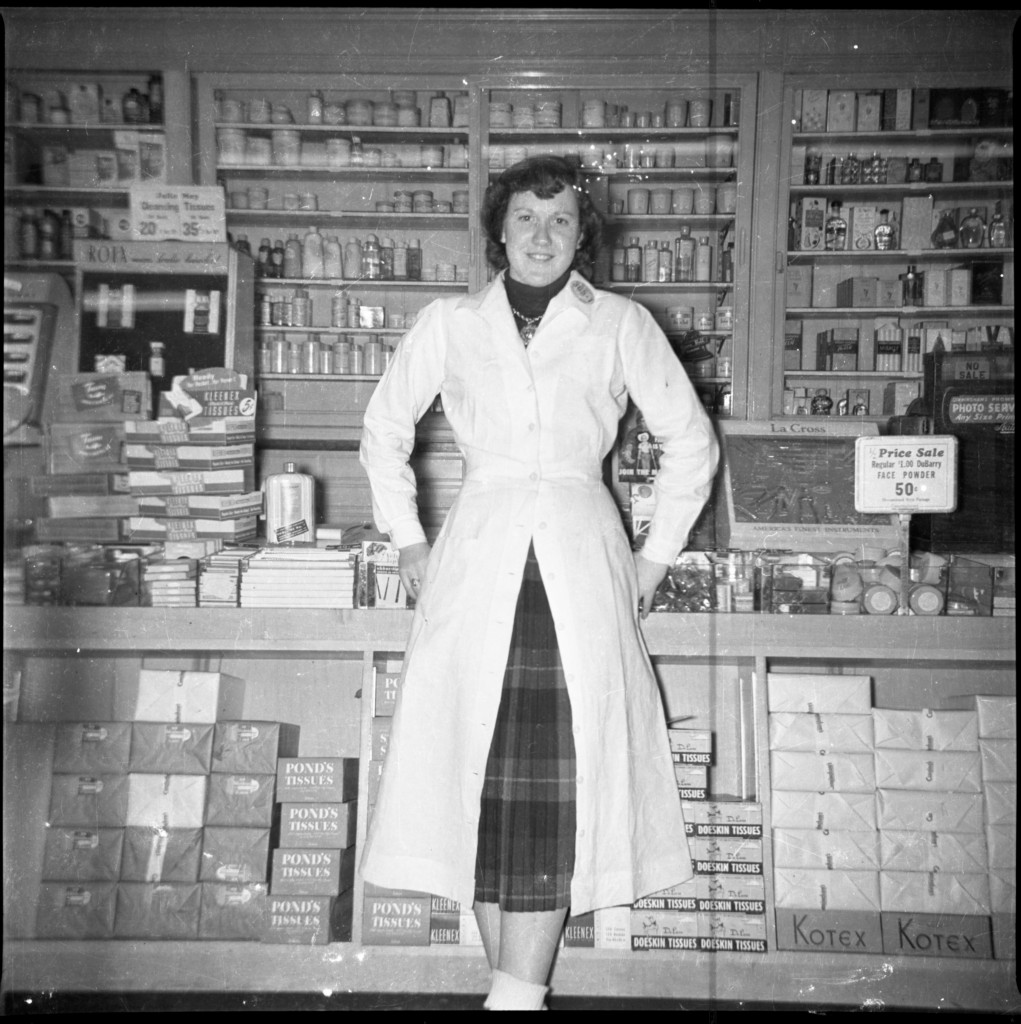
Below, she’s hopped up onto the liquor counter. By looking closely at the whisky prices that happen to appear in the previous sequence, my best guess is that this sequence was taken at about the same time, or shortly before — the arrangements of the bottles are slightly different, but the prices are the same, except a couple are a penny or two cheaper.
We also get a closer look at our mystery woman’s badge. It says “365-1”, with some illegible writing above and below. This makes me think it’s some kind of state license badge, maybe for a pharmacist, or an inspector of some kind? It’s hard to say.
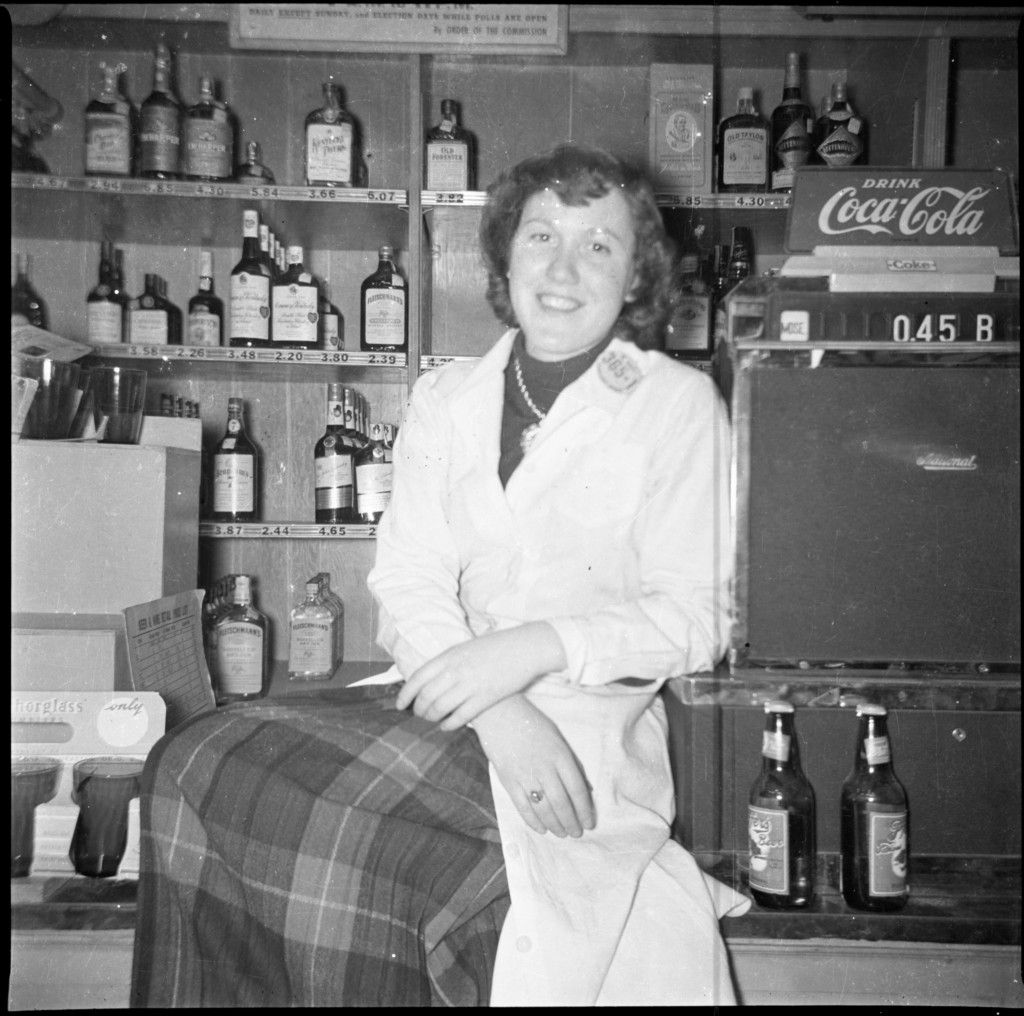
The two photos above were at the end of a film roll, but the sequence continues on another roll, with the frame below. We can be fairly certain that the sequence connects here because the cash register still reads 0.45, and the two beer bottles in front of the register haven’t moved.
Wow, cases of the original Stroh’s, Altes, and Pfeiffer’s — all Detroit beers, before they were merged and consolidated out of existence. I can even spot a couple of bottles of Vernors — can you?
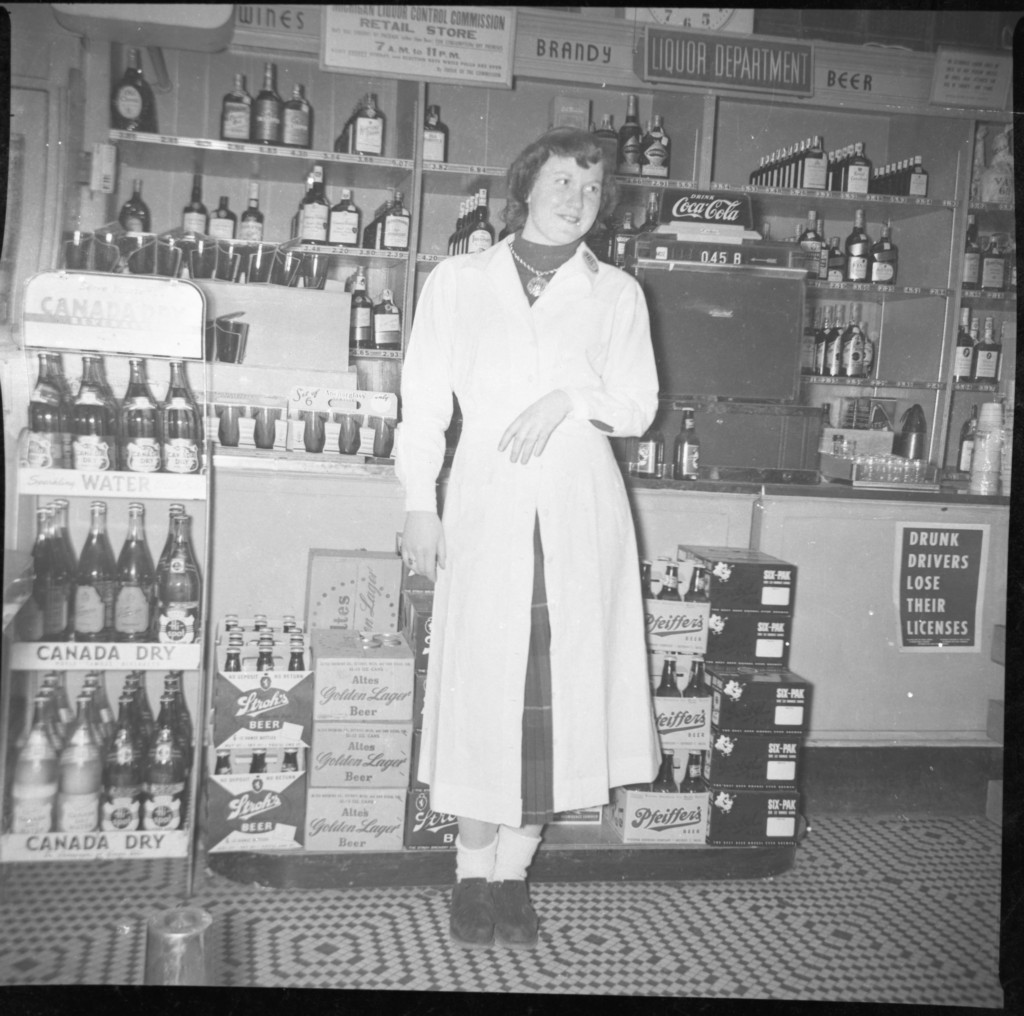
Now she’s moved to the candy counter for another portrait. A couple of the brands are familiar, but the rest are a complete mystery to me. Most likely, everything in this picture is packaged in waxed paper or cellophane — packaged sustainably, that is — and it doesn’t seem to stop it from selling. We could learn a bit from that.
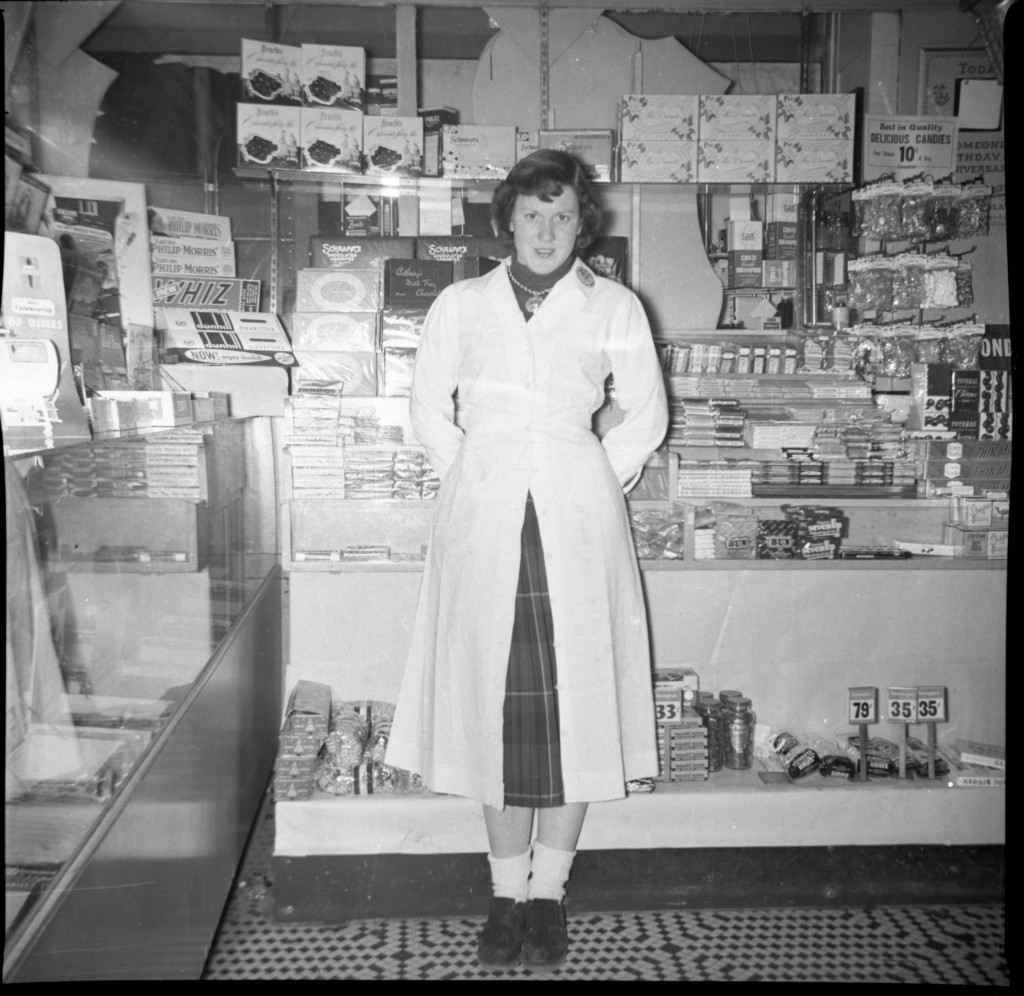
Below, she’s removed the smock, and is posing at the lunch counter. There is some damage to the negative, but it gives us a good view of the tin ceiling and the front entry in the distance. I count at least 13 stools, probably 14, with more likely unseen behind the camera.
Why has she removed her smock? Is it the end of her shift? Is she waiting for Dad to get done with his, so he can take her out on the town?

Probably not. Again, he’s keeping his smock on. Nothing but a friendly hug, followed by a series of unrelated scenes taken elsewhere, to finish out the roll.
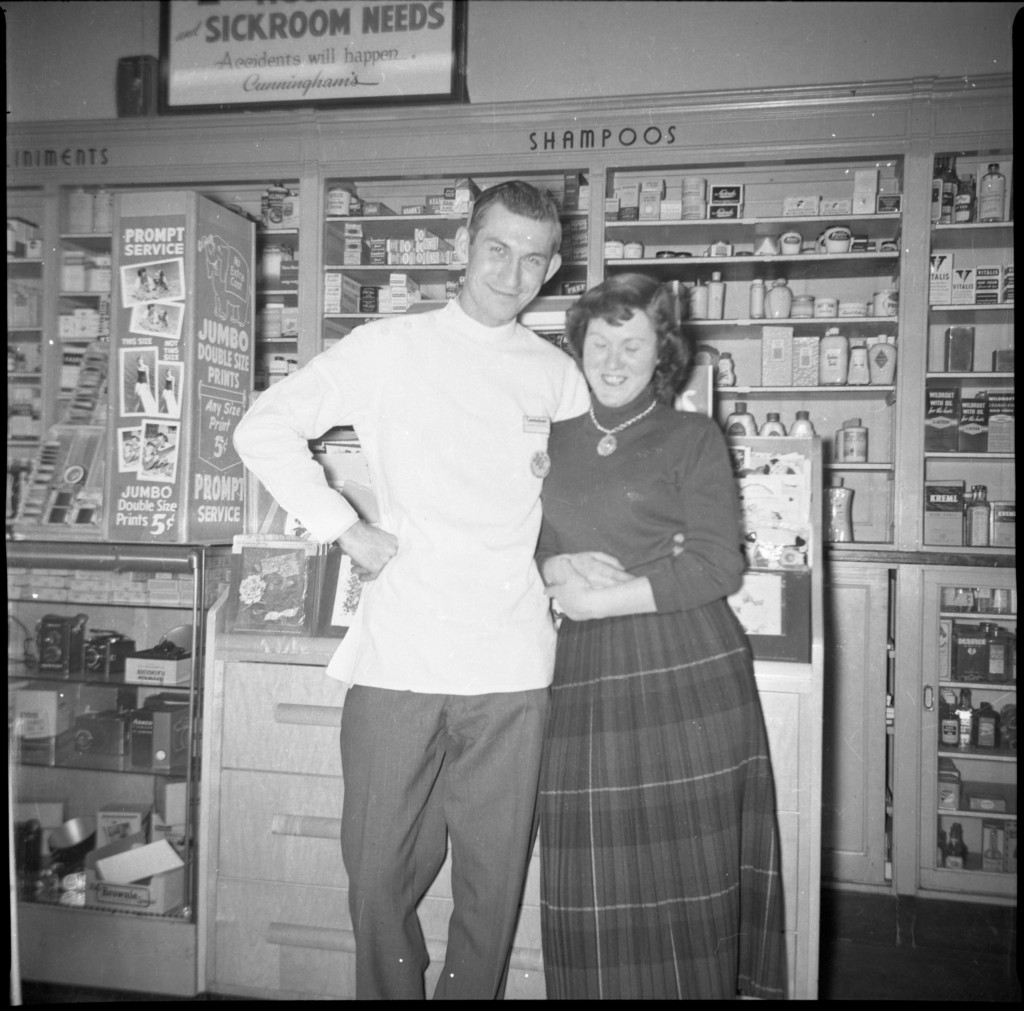
But wait — looking again, is he wearing her round badge now? It seems to have the same number. Or was it his badge to begin with, and she was wearing his smock? On the other hand, her smock was obviously much longer. Hmm.
With so many scenes, in so many different departments, it makes me think perhaps she’s about to change jobs, and has merely asked Dad to shoot some photos for her to remember things by, before she turns in her badge. Then Dad put it on for fun. But it’s impossible to say. Sometimes old photos pose as many questions as they answer.
Family history suggests that at about this time, my father was poised to graduate, marry my mother, and begin his new career. It’s tempting to speculate that he brought the camera for his going-away party. Or perhaps it was just his last shift at Cunningham’s. The fact that he went to the trouble to hand the camera off to someone else and get into the frame — twice — suggests that perhaps it may have been a special occasion of some sort. But it’s all speculation, and it’s too late to ask him.
Sequence 3: Cunningham’s in color
And finally, a real treat — color slides! Below we have two, which I found together in a slide tray. These were either mounted incorrectly in their slide mounts, or they have shifted, which is why you can see the sprocket holes of the film. This means that some of the image is obscured and probably unrecoverable under the glue of the holder.
Here we see a better image of the liquor shelves, and a happy liquor clerk, handling a bottle of Haig & Haig whisky. Did Cunningham’s really dress its liquor clerks in a white shirt? Or is this the pharmacist, recommending an alternative medicine?
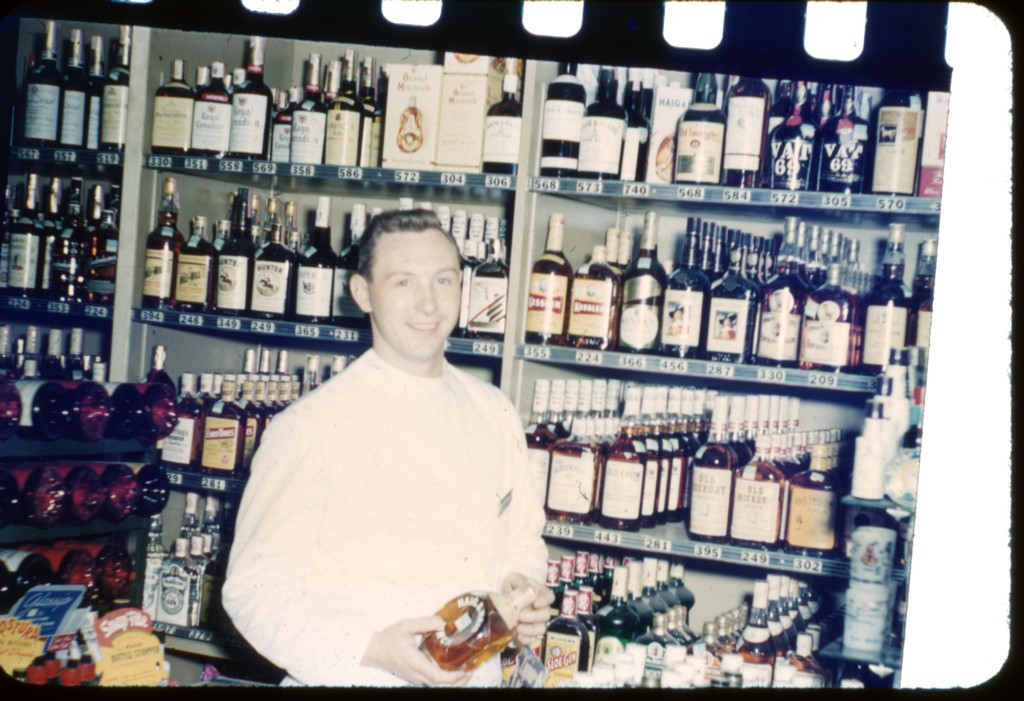
Below we see two servers who were not in the previous pictures. We know it follows the previous frame because there’s a bit of double exposure to the left. Again it seems to be nighttime, as no obvious light is coming in through the glass blocks. However, while the previous frames were shot in the winter, these seem to be in the summer. My main clue is the merchandise display behind the servers, which exhorts us to join their “Bar-B-Q Picnic” while advertising an inflatable pool for $4.99 — unlikely for winter. On very close examination of the previous slide, we can also see that in some cases the liquor prices are a few cents higher than in the black-and-white frames. Circumstantially then, this might be summer of 1952. Perhaps Dad has come back for a visit, to catch up with his old friends.
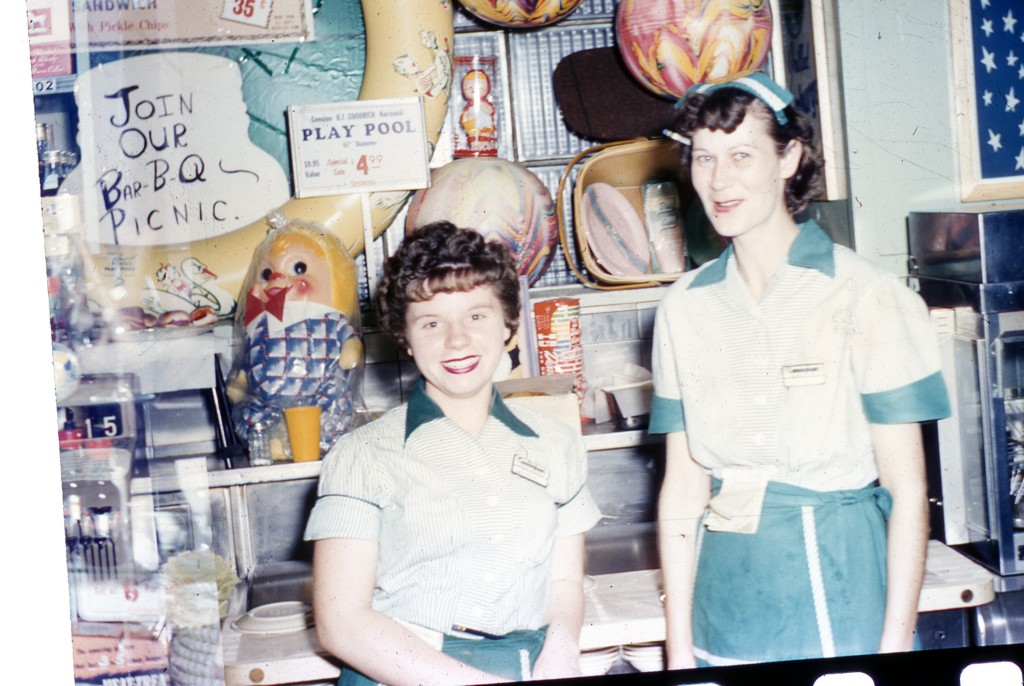
Part 2: A brief visit to the site
How do I know that these pictures were taken at the Ypsilanti Cunningham’s? I don’t remember specifically being told that he worked at that location; only that I had grown up having that general perception. But there were multiple locations in the area, where he just as likely might have worked.
The only way to find out for sure was to take a trip to the site, in the hopes of recognizing something in the pictures.
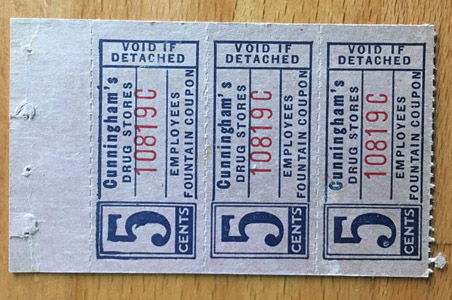
Thankfully, the building still exists, and is largely unaltered. Below is the downtown Ypsilanti store as it appeared in the mid-1950s, and below that, as it appears today. Intriguingly, even the entry doors at the corner, and to the apartments upstairs, seem to be entirely original. The Cunningham’s space is now occupied by Mix Ypsilanti, a locally owned eclectic clothing store.
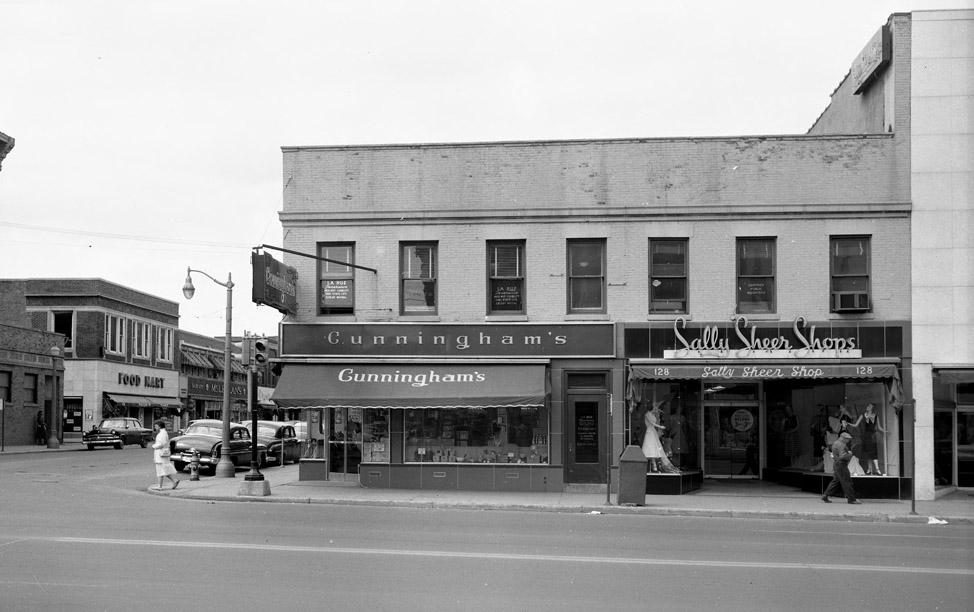

Glass blocks
Glass blocks turned out to be the key that links the photos to the site.
On the west side of the building I was able to locate two banks of structural glass blocks, that appear to be the same style as seen in the photos. They are no longer visible from the inside, but their continued presence today on the outside suggests that they were functional when the photos were taken. This helps support the idea that the photos were taken at night, as the blocks would have been letting in a lot of light if the photos were taken in the daytime.
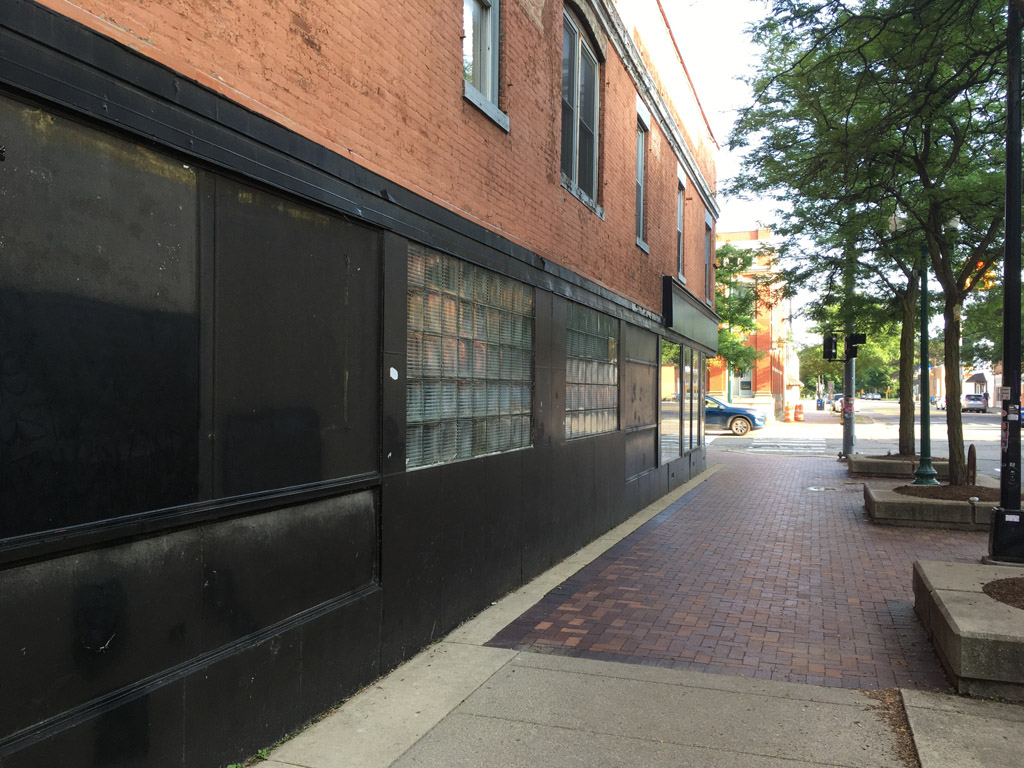
The glass blocks in the liquor department provide a more definitive clue. At the top of the very first photo (enhanced below), we saw two banks of glass blocks above the liquor department — one bank of five blocks in width (partially hidden by the clock), and one of six.

At the rear of the building, I spotted the same. They have since been painted over, but they appear to be of the same type as on the west side of the building, having a perfectly flat surface (the ribbing is internal to the block), and joined with mortar. The odd configuration of five and six seems fairly definitive at identifying the location.

Finally, I walked in to the Mix clothing store, the current occupant, to see what I could see from the inside. I was surprised that the friendly and knowledgeable clerk was already very familiar with the history of the building, including its stint as a drug store. After a chat and a brief tour, she graciously allowed me to take a few pictures. Below, we see the view toward the front door, which can be compared to the photo in the second sequence, where the woman looks back at us from the counter. The lunch counter and stools would have stretched along the right wall. The tin ceiling and the molding around the door are identical in both pictures. The intricately tiled floor, however, is no longer visible.
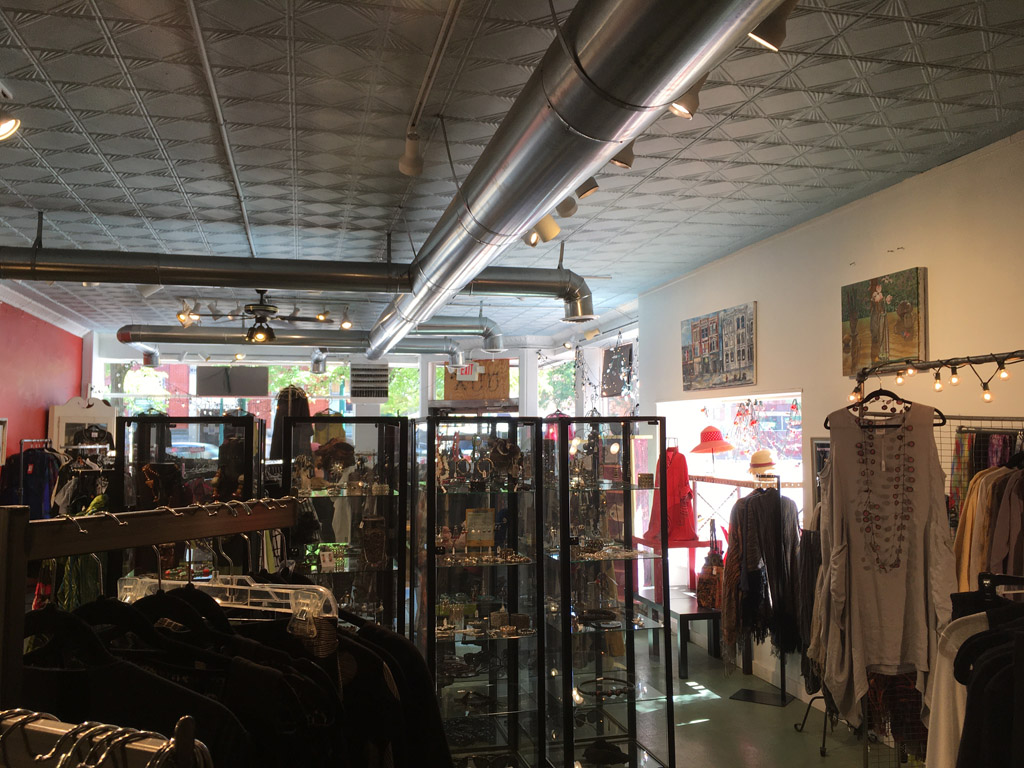
As I exited the shop, I felt quite certain that the vintage, metal-and-glass entry doors were the same ones my father once used, and perhaps even had locked up every night. As I pulled one open and passed through, I almost felt a chill, as if I was stepping out of some long forgotten chapter of my father’s private, pre-marriage life.
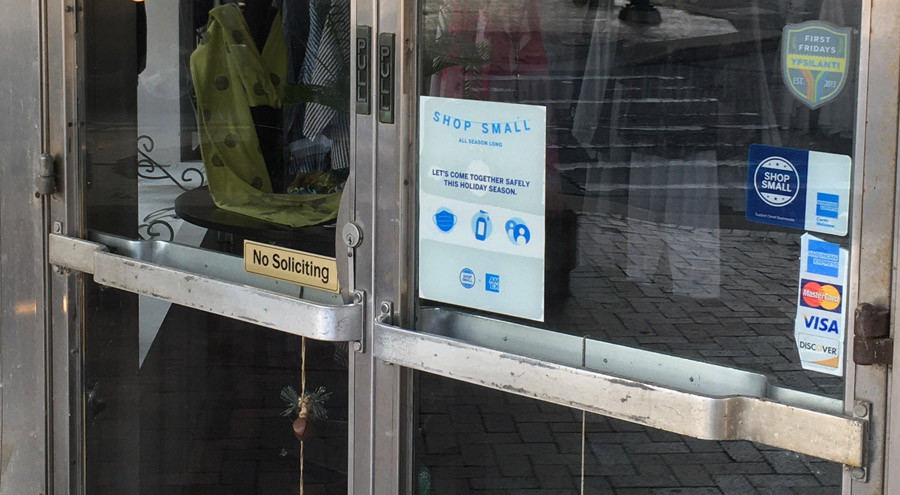
But no, it was just a nice little clothing store on Michigan Avenue. If there are ghosts here, they seem to be friendly.
Conclusion
It seems reasonable to conclude that these photos were taken at the downtown Ypsilanti Cunningham’s, between late 1951 and early 1952. The date is supported by a calendar, and by the likely dates of my father’s employment at Cunningham’s. The location is supported by architectural details of the building that also appear in the photos.
The photos indicate that the lunch counter (or soda fountain) was located along the west side of the building, and included no less than 13 stools, probably more, where you could definitely get a fried egg sandwich, with pickle chips. There was also a pharmacy counter, a candy counter, and a cosmetics counter. The liquor department was at the rear, and held some fascination for the staff of the other departments. The exact location of these other departments might also be deduced by careful examination of the photos.
I’ll leave that as an exercise for others. As for me, I’m going to put these photos back into their box for a while.
And ponder, perhaps, a new appreciation for architectural glass blocks.

Article and images Copyright 2022 by the author.
For permission to reuse images or to learn more, email the author via the About page.
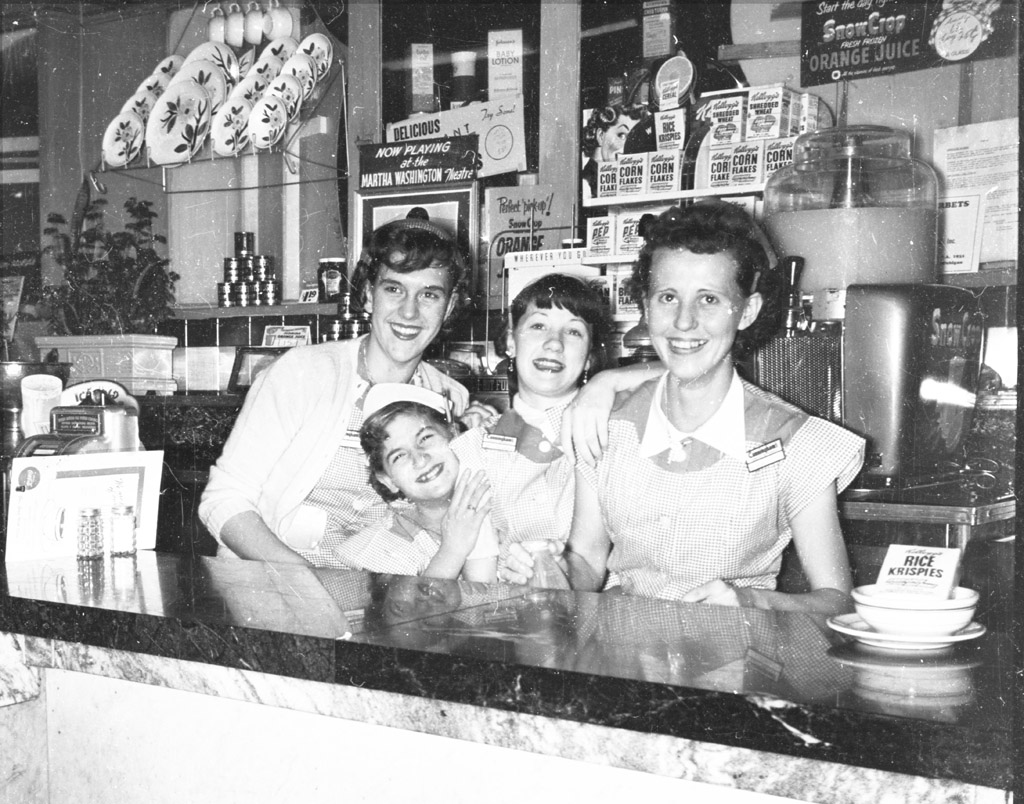


One Comment
Stephanie Leach Basar
I just met my sister(she’s 73, I’m 70) for lunch 2 days ago and we randomly discussed memories of Cunningham’s and our Saturday walks uptown to the soda fountain for vanilla coke and fries, nail polish bins (for .25) and other memories. Then yesterday I picked up a friend from assisted living (she has early dementia) nearby and we drove by Cunningham’s and shared OUR memories! My sister sent your pictures to me last night. In the mid 60s I was there with friends when Lyle Talbot came in with a camera around his neck and was taking a photo of the big ‘scale’ at the front door. He was Ozzie and Harriet’s neighbor from the TV series. He signed his autograph on a scrap piece of paper. Thank you.